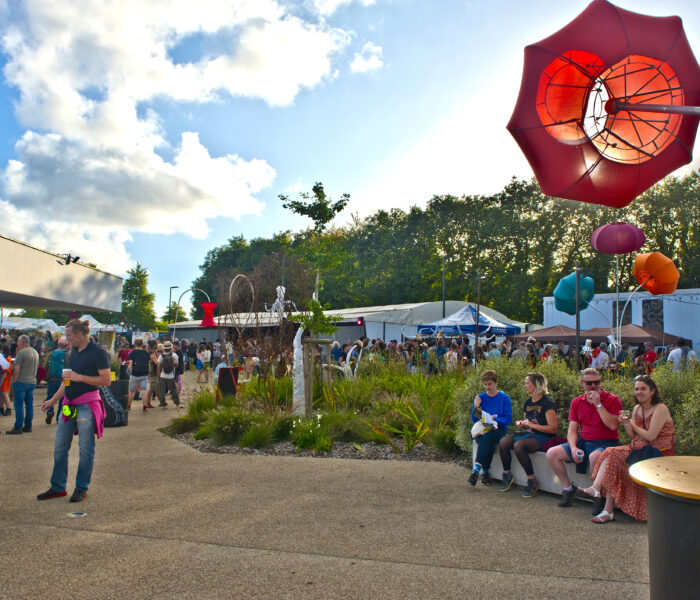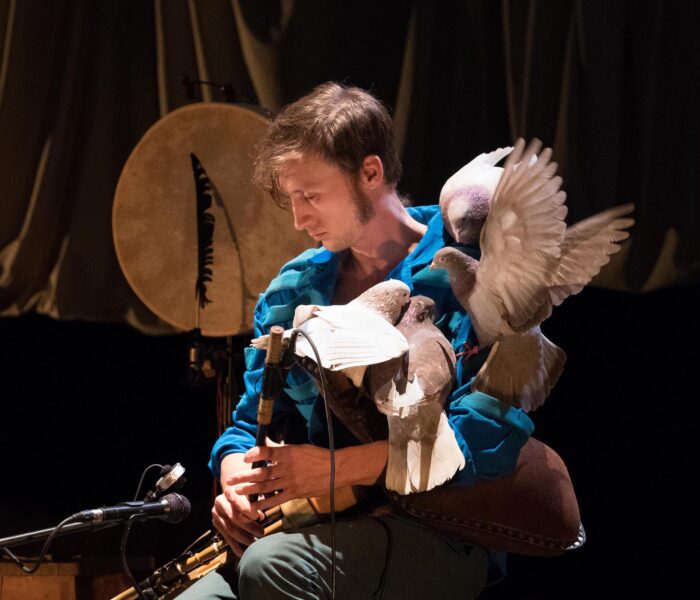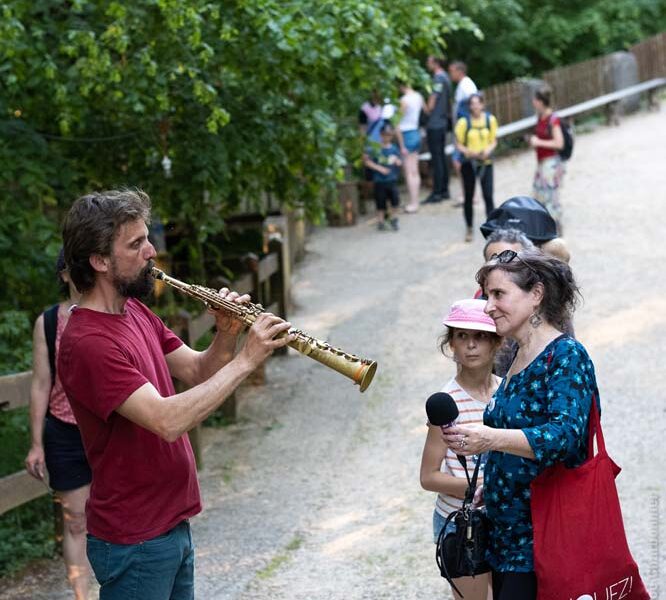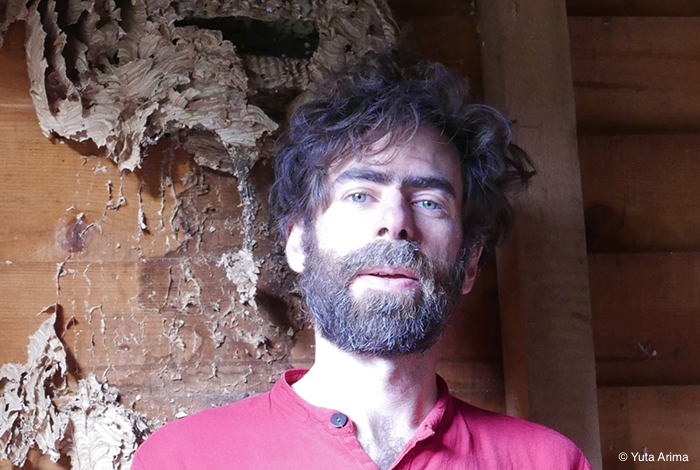Projets de territoire ambitieux et transgenres créés juste avant l’été, la « suite électro-orchestrale » Mulhouses et le « micropéra dégenré » TRANSFoRMERS marquent deux nouvelles étapes importantes dans le cheminement singulier de Jonathan Pontier, compositeur aiguillé par sa passion pour le collectif et la transmission. Tout en posant des questions sur les modalités de ce type de créations à l’ère post-Covid, dans un contexte institutionnel de plus en plus complexe.
Portrait du compositeur en composteur
Sur son site Internet, la biographie de Jonathan Pontier décline sur un mode poético-facétieux les ressources de son patronyme : « fabricant de ponts ». Des passerelles, en effet, le compositeur n’a eu de cesse d’en bâtir depuis que, voilà déjà deux décennies, il a déboulé dans le paysage musical. Presque par hasard, serait-on tenté d’écrire, puisque c’est tardivement, au lycée, que cet enfant du 9-3 (il a grandi à Montfermeil), biberonné au rock et aux musiques urbaines, a découvert la musique contemporaine, et avec elle un « rituel social » pour lequel il n’avait pas été « domestiqué ». S’il est passé par l’Ecole Nationale de Musique et de Danse de Montreuil puis le Conservatoire National Supérieur de Musique de Paris (où il a obtenu un prix de composition et nouvelles technologies), s’il est également pianiste, guitariste et virtuose de la MAO (musique assistée par ordinateur), il continue de se présenter comme « principalement autodidacte », et de prendre un malin plaisir à déjouer les académismes et les catégories pour mieux faire le lien entre les différents mondes qui le constituent. En 2007 – année où il remporta le prestigieux Prix Italia –, sa première collaboration avec l’Ensemble Intercontemporain avait pour titre (De)fragmentations on Bob Dylan ; et cet été, ce sont les albums Grand Wazoo et Waka Jawaka de Frank Zappa qu’il a revisités (après les avoir relevés à l’oreille !) en compagnie d’un ensemble d’instrumentistes polymorphes, Mega Wajooka – un projet qui, avis aux programmateurs, ne demande plus qu’à tourner. Du théâtre (avec le metteur en scène Jean Boillot) au conte musical pour enfants (Dansekinou, 2014), en passant par la danse (GayaMix, 2023), il a exploré (et explosé) une multitude d’univers avec une faconde quasi dadaïste et une énergie communicative. « Pas de création sans transmission », aime-t-il à répéter – il le disait déjà à Suzanne Gervais ici même il y a deux ans ; et pas davantage « de transmission sans création » : au CRR d’Aubervilliers-La- Courneuve, où il enseigne depuis 2018 la composition, il a créé un collectif de jeune création : « Transmettre un savoir sans le renouveler, sans le requestionner profondément, ça n’a pas de sens non plus. »
C’est finalement cette dimension collective – davantage que simplement « participative » – qui est au cœur du travail de Jonathan Pontier : « J’ai toujours pensé qu’il était plus intéressant de faire ensemble ou de ‘faire faire’ que de se plier au schéma classique : j’écris – j’ai fini d’écrire – je fais avec les musiciens. J’ai toujours pensé qu’il fallait pouvoir ‘fabriquer son public’. A l’ère d’Internet, qui a permis de développer une culture de la collaboration, ce qui est vraiment ‘d’avant-garde’ en termes d’écriture, c’est peut-être justement d’œuvrer ensemble à fabriquer l’œuvre. Ce qui concourt à créer une culture commune de l’œuvre, c’est de la faire ensemble, plutôt que d’assigner les autres à la position de ‘public’. Il ne s’agit pas du tout de dénigrer mon travail, au contraire, mais plutôt de se demander ce que concrètement je peux apporter à un corps social – un corps social que l’on a pu définir comme ‘public’. A partir de là, l’hermétisme qui est souvent associé à la création contemporaine disparaît de lui-même. » Cette générosité, cette curiosité et cette ouverture naturelle à l’autre sont l’une des caractéristiques les plus frappantes et les plus attachantes de la musique de Jonathan Pontier : il n’est plus besoin de « cocher des cases » (« action (socio-)culturelle », « participation », « éducation artistique », « projet pédagogique », autant d’appellations-valises que l’intéressé dit lui-même « ne pas reconnaître ») lorsque l’art est, comme chez lui, aussi viscéralement arrimé à une dimension culturelle. Quels que soient les qualificatifs loufoques dont il s’affuble (« électro-troubadour », « passeur d’inventions », « organisateurs d’intuitions », « citoyen du son », « artisan symphoniste », « homme-orchestre »), on pourrait dire finalement que chez Jonathan Pontier, le compositeur est aussi un « composteur » : je ne parle pas ici de cette machine qui sert à valider les titres de transports, mais de ce grand réceptacle où l’on met à fermenter les déchets naturels pour en récupérer les éléments riches en minéraux et en matière organique, et s’en servir pour fertiliser les sols. Chez cet artiste nourri de mille références hétéroclites, le ferment, c’est les autres, sans exclusive.
Deux projets atypiques sont encore venus le prouver ces derniers mois.
Mulhouse music
Il y a tout d’abord eu le projet Mulhouses – avec un « S », sic : « Le S du pluriel, de la diversité, de la multitude ! L’envie à la fois de faire unité – la ville, à la fois cette ville et toutes les villes, la cité, la fabrique du citoyen – et de dire qu’il n’y a pas un point, un centre, une ville : il y a toujours mille réalités… » Créé le 9 juin, cette « suite électro-orchestrale » en cinq mouvements, écrite pour un orchestre symphonique, six musiciens électro et un chœur de plus de 250 enfants (!) issus du conservatoire et d’établissements scolaires de la ville, fut l’aboutissement de cinq années d’un patient travail que la pandémie n’a pas réussi à arrêter. A l’origine de celui-ci : une commande citoyenne passée en 2018 dans le cadre du programme des « Nouveaux commanditaires » de la Fondation de France, permettant à « des citoyens confrontés à des enjeux de société ou de développement d’un territoire de faire appel à l’art » – en l’occurrence, cinq Mulhousiennes et Mulhousiens désireux de donner une autre image de leur ville.
Dans ce processus, l’utilisation de l’électronique s’est imposée dès le départ comme un parti pris artistique… et comme une nécessité économique : « Ce côté électro presque ‘vintage’ – je cite souvent ce disque de Stevie Wonder que j’ai appris à chérir progressivement, Journey Though The Secret Life of Plants, avec des sons très avant-gardistes en termes de lutherie électronique et en même temps très rugueux, très datés – m’est apparue comme une bonne traduction de la ville. Mulhouse, comme Porto par exemple, c’est un peu ça : une espèce de campagne presque ville, ou de ville-monde à la gloire passée, avec beaucoup de mémoires, notamment immigrées… Dès que tu arrives dans cette ville, tu sens cette patine. Mulhouse, c’est un peu la fille oubliée de l’histoire, tout le contraire de la rutilante Strasbourg… Mais le choix de l’électronique obéissait aussi à une autre raison : au début, on n’avait tout simplement pas d’outils de production, pas d’ensemble, pas de musiciens… »
Ce n’est que dans un second temps que l’Orchestre symphonique de Mulhouse s’est embarqué dans l’aventure, et que le projet a pu prendre peu à peu sa – monumentale – forme finale, porté par l’enthousiasme d’une équipe artistique hyper investie, sous la houlette du chef d’orchestre Dylan Corley : « Ce fut assez fantastique, et la création s’est divinement bien passée. Je dois dire que je ne m’attendais pas à rencontrer une telle adhésion de la part de l’orchestre, que ce soit à la musique ou à la nature transversale du projet. Dès la première séance, il était au top, notamment rythmiquement. Et c’est une vraie nouveauté par rapport à ce que cela pouvait être il y a quelques années : les musiciens sont vraiment en demande de ce type de projets un peu ‘crossover’. Il faut dire que Dylan Corley, qui joue aussi bien avec l’Ensemble Intercontemporain qu’avec MC Solaar, n’a pas peur du ‘clic’, de la technique, de l’amplification… » Le résultat musical, presque « pop » aux dires de son auteur, est une fresque où des accélérations endiablées voisinent avec des instants dilatés dans lesquels les voix des enfants semblent reproduire des effets de delay… jusqu’à cet « hymne » qui, « chanté par des gamins, devient presque une bluette de variété. Mais c’est quelque chose que j’assume complètement, même en tant que ‘compositeur contemporain’. » Par son syncrétisme stylistique et sa volonté rassembleuse, Mulhouses rappelle Le Geste et la parole, que Jonathan Pontier créé en 2007 dans sa ville de Clichy-sous-Bois : une autre composition foisonnante et hétérodoxe, réunissant soixante-quinze musiciens et choristes amateurs de Seine-Saint-Denis, et mêlant percussions, musiques électroniques et voix, djembé, tambour de cavalerie, sourdos brésilien et darbukas, MAO et slam…
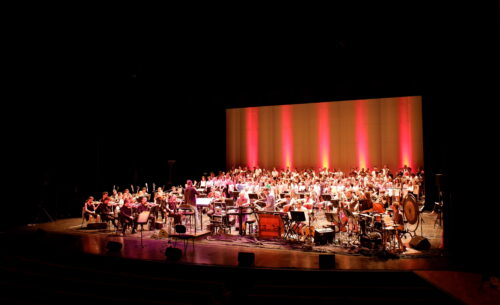
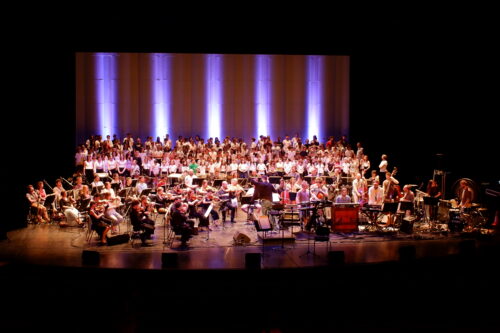
Opéra transformiste
C’est la rencontre avec un autre jeune chef d’orchestre intrépide et au « relationnel de ouf » – Léo Margue, directeur artistique de l’ensemble 2e2m depuis 2022 – qui a présidé à la réussite du projet TRANSFoRMERS, créé le 31 mai dernier : une fresque collective musicale et visuelle – le compositeur la qualifie de « micropéra dégenré » – élaborée au cours d’une résidence de territoire associants écoliers et habitants de la ville de Champigny-sur-Marne, où 2e2m est implanté.
A l’origine, il y avait un rêve d’opéra, inspiré à Jonathan Pontier par les figures de Sabbataï Tsevi (ce « faux messie » qui, au XVIIe siècle, provoqua un schisme profond au sen du judaïsme) et de Chelsea Manning (lanceuse d’alerte qui, au lendemain de sa condamnation en 2013, entama sa transition et son changement d’identité de genre) : deux figures invitant à réfléchir à la notion de « transformation ». De ce propos de départ, c’est l’idée de « transformation » qui est principalement restée, TRANSFoRMERS devenant une manière de questionner collectivement les mutations de la ville et du monde. Et de mener avec les enfants un travail au long cours qui, de l’avis de tous (à commencer par leurs parents), a produit des résultats étonnants. « Nous avons d’abord passé plusieurs mois à expérimenter avec les trois classes de l’école élémentaire Irène Joliot-Curie, via du jeu vocal, du mouvement, de la percussion corporelle. Essayer des situations de son, tester les choses avant de les écrire, valider des hypothèses – tout ce qu’on appelle la ‘mise en jeu’ dans le théâtre contemporain –, c’est quelque chose que j’adore faire, et qu’on ne développe pas assez, à mon avis, dans la musique dite ‘contemporaine’. Un autre aspect intéressant, quoique difficile, a été de travailler sur la mémorisation, sur ce que peuvent retenir des enfants, et sur les manières de fabriquer une partition qui soit presque uniquement gestuelle. La partition fait voisiner des formes uniquement chorales et des choses un peu ouvertes, avec un système de ‘cartes’ renvoyant soit à des objets sonores, soit à des éléments de partition appris, qui viennent se greffer sur les parties instrumentales beaucoup plus écrites et verrouillées… ».
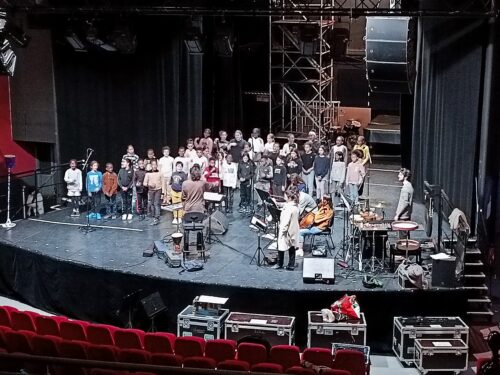
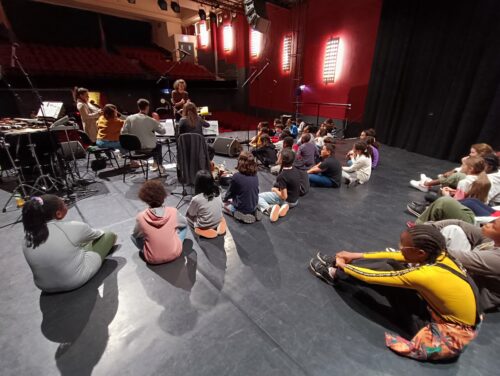
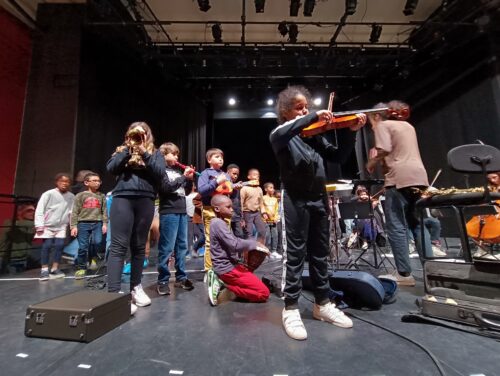
Accompagnée par un dispositif sonographique et vidéo (conçu avec l’aide de La Muse en Circuit et du vidéaste Olivier Garouste), des percussions et un trio à cordes, la soprano Marie Soubestre incarne tous les personnages, tandis que le chœur, à la manière du chœur antique, porte le propos sur la transformation. « Cela faisait longtemps que je n’avais pas vu des enfants aussi impliqués dans un projet, avec une telle capacité de mémorisation des textes, et une curiosité, une qualité d’écoute et de geste vraiment très impressionnantes. » Un essai que Jonathan Pontier aimerait beaucoup poursuivre et transformer ailleurs (pourquoi pas à Aix-en-Provence, par exemple ?), une fois que la captation vidéo de la première aura été finalisée.


Courts-circuits et circuits courts
Car si tout s’est parfaitement bien passé avec les enfants, c’est plutôt du côté des adultes que l’expérience s’est avérée, à certains égards, frustrante. Et en particulier du côté d’une Education Nationale extrêmement frileuse et interventionniste, au point d’obliger le compositeur à réécrire une bonne partie de son livret et de l’expurger de toutes les références susceptibles de « heurter les sensibilités », comme l’on dit. En d’autres termes, « il y a des choses qu’il est devenu presque impossible de faire dans le cadre de l’Education nationale. Sur le principe, c’est quelque chose de vraiment problématique ». De même, au sujet de Mulhouses, Jonathan Pontier déplore-t-il les nombreux obstacles qu’il a eu à affronter en termes de production et d’administration.« Il faut le dire, que tout n’est pas rose ! Que ce n’est pas parce qu’on arrive à faire les choses qu’on a le sentiment qu’elles sont faites avec sens à tous les échelons de la production ! En creux, ces deux projets, en dépit du fait qu’ils ont pu être réalisés – et bien réalisés –, me semblent démontrer la complexité de plus en plus grande, pour un artiste, de ‘produire’ dans ce contexte post-Covid. Et posent un certain nombre de questions : quelle place l’artiste a-t-il véritablement, in fine, dans ce type de projets ? quelle marge de manœuvre lui est-il laissée, dans son artisanat et dans sa faculté de nous déplacer ? N’est-on pas en train de tomber dans une productivité un peu aveuglée par l’obsession de cocher les cases de la politique culturelle ? Ce n’est pas une critique du système en tant que tel, mais plutôt un questionnement sur la place que doit retrouver l’artiste (au féminin comme au masculin, au singulier comme au pluriel) dans ce maillage institutionnel devenu de plus en plus complexe… Paradoxalement, dans une époque où on n’a jamais autant promu les projets de création artistique à vocation ‘sociale’, un basculement me semble être est en train de se produire dans la notion même de ce qui fait œuvre : c’est quelque chose d’hyper intéressant, mais j’ai l’impression qu’on ne se donne pas les bons outils de réflexion… »
Au-delà de ces frustrations, ces deux projets auront au moins eu le mérite de renforcer une conviction : « Le circuit court, c’est aussi important dans la culture que dans l’agriculture. » Autrement dit, ce n’est que par sa dimension (son ambition) collective que l’art (et la musique contemporaine en particulier) peut se transformer en culture.
David Sanson
Photos © François Barbier et Pernelle Gaufillet Ventura
Photos © Jonathan Pontier
Photos © Eric Garault
Photos © New Nabab



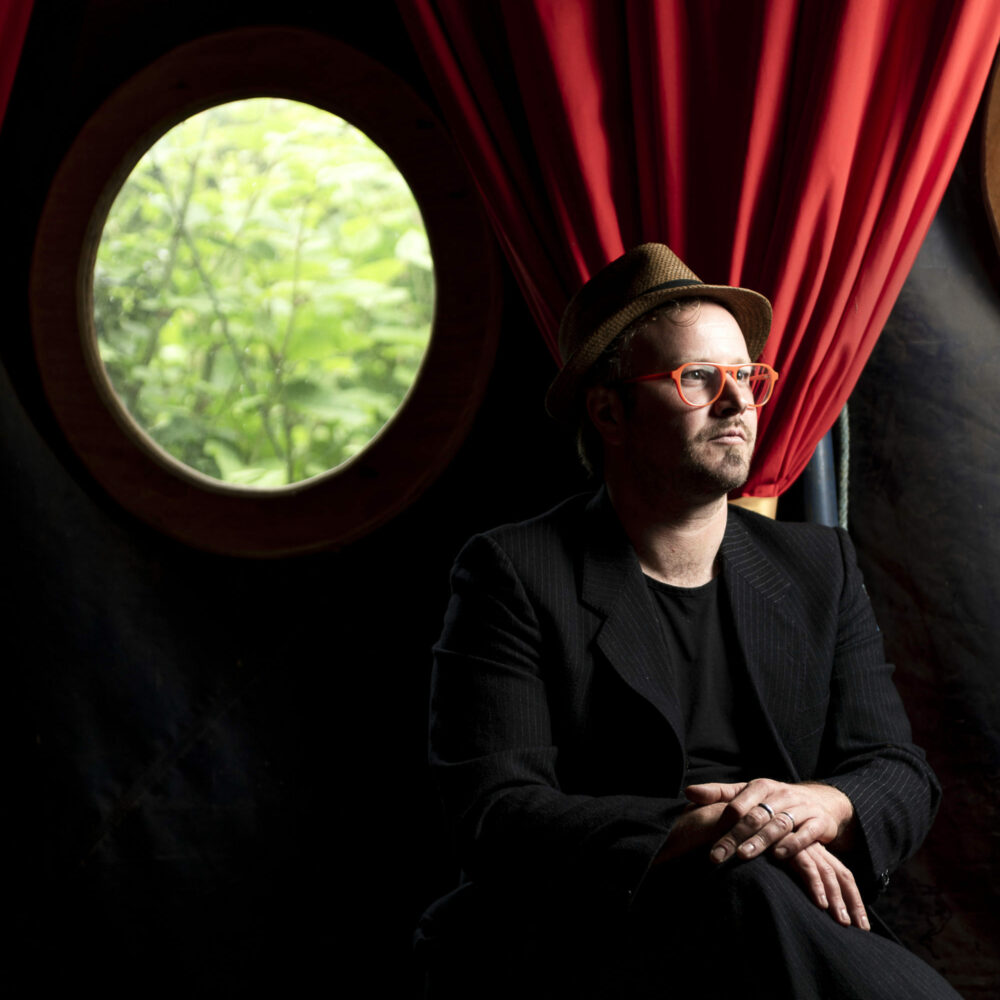)
